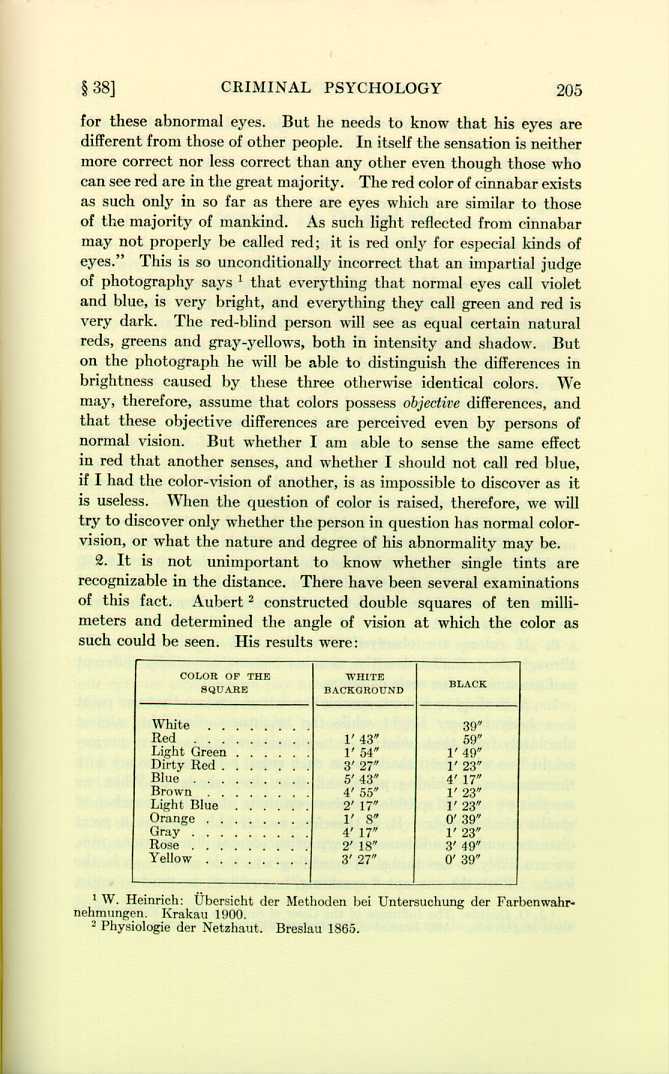| Topic I. OF SENSE-PERCEPTION. Criminal Psychology: a manual for judges, practitioners, and students | ||
Section 38. (2) Color Vision.
Concerning color vision only a few facts will be mentioned: 1. It will be worth while, first of all, to consider whether color exists. Liebmann holds that if all the people were blind to red, red would not exist; red, i. e., is some cervical phantasy. So are light, sound, warmth, taste, etc. With other senses we have another world. According to Helmholtz, it is senseless to ask whether cinnabar is red as we see it or is only so as an optical illusion. "The sensation of red is the normal reaction of normally constructed eyes to light reflected from cinnabar. A person blind to red, will see cinnabar as black, or a dark grayish yellow, and this is the correct reaction
2. It is not unimportant to know whether single tints are recognizable in the distance. There have been several examinations of this fact. Aubert[2] constructed double squares of ten millimeters and determined the angle of vision at which the color as such could be seen. His results were:
It is interesting to notice that the angle for blue on a white background is almost nine times that for white, orange, or yellow on a black background. In cases where colors are of importance, therefore, it will be necessary to discover the color and the nature of its background before the accuracy of the witness can be established.
3. It is well known that in the diminution of brightnesses red disappears before blue, and that at night, when all colors have disappeared, the blue of heaven is still visible. So if anybody asserts that he has been able to see the blue of a man's coat but not his red-brown trousers, his statement is possibly true, while the converse would be untrue. But there are no reliable or consonant accounts of the order in which colors disappear in increasing darkness. The knowledge of this order would help a great deal in the administration of criminal justice.
4. The retina will not see red at the periphery, because there are no red rods there. A stick of red sealing wax drawn across the eye from right to left, appears at the periphery of the visual field to be black. If, then, a witness has not looked right at a definitely red object, and has seen it askance, he has certainly not observed its color. The experiment may be made by anybody.
5. According to Quantz[3] objects in less refractable colors (red, orange, yellow, and purple) look 0.2 to 3.6% bigger against white, while blue, blue-green, and violet objects appear from 0.2 to 2.2% smaller. Dark and long-lined objects seem longer; bright and horizontal seem wider. And these facts are significant when witnesses judge of size.
6. If colors are observed through small openings, especially through very small holes, the nuances become essentially different and green may even seem colorless.
7. According to Aubert, sparkle consists of the fact that one point in a body is very bright while the brightness diminishes almost absolutely from that point; e. g., a glancing wire has a very narrow bright line with deep shadows on each side; a ball of mercury in a thermometer, a shining point and then deep shadow. When we see this we say it sparkles because we unite it with a number of similar observations. It is therefore conceivable that at a great distance, under conditions of sharp or accidental illuminations, etc., we are likely to see things as sparkling which do not do so in the least. With the concept "sparkling," moreover, we tend to unite,
| Topic I. OF SENSE-PERCEPTION. Criminal Psychology: a manual for judges, practitioners, and students | ||
